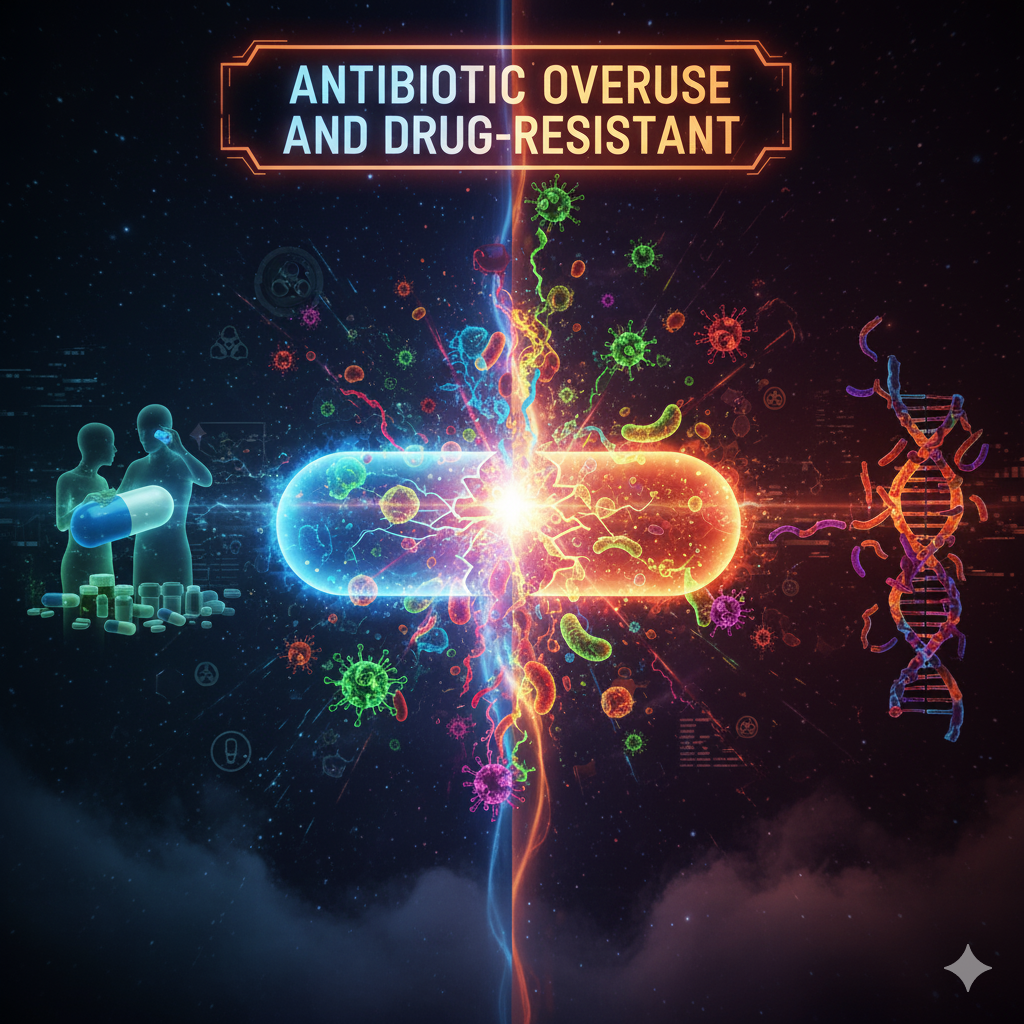Introduction
Antibiotics have been hailed as one of the greatest medical innovations of the 20th century, significantly reducing mortality from bacterial infections. However, their overuse and indiscriminate availability have led to a global public health crisis: antimicrobial resistance (AMR). India, being one of the largest consumers of antibiotics in the world, faces an acute threat from drug-resistant diseases, which compromise treatment efficacy, increase healthcare costs, and endanger millions of lives.
This essay explores the connection between antibiotic overuse and the emergence of drug-resistant pathogens in India, evaluates existing mechanisms for monitoring and controlling antibiotic usage, and critically discusses the complex socio-economic, regulatory, and health-related issues surrounding AMR.
1. Understanding Antibiotic Overuse and Drug Resistance
1.1 What Constitutes Antibiotic Overuse?
Antibiotic overuse occurs when antibiotics are:
- Prescribed unnecessarily for viral infections, such as influenza or the common cold.
- Used excessively or for prolonged periods, beyond the prescribed dosage.
- Administered without medical supervision, including self-medication or purchasing over-the-counter antibiotics.
- Used in agriculture and livestock as growth promoters or prophylactic agents, contributing to resistance in humans indirectly.
1.2 Mechanism of Drug Resistance
Drug resistance develops when bacteria evolve mechanisms to survive exposure to antibiotics. Key mechanisms include:
- Enzymatic degradation of antibiotics (e.g., β-lactamases breaking down penicillin).
- Efflux pumps that expel drugs from bacterial cells.
- Target site modification rendering antibiotics ineffective.
- Biofilm formation, creating a protective barrier for bacteria.
Overuse accelerates this process, selecting for resistant strains that survive and proliferate.
1.3 Drug-Resistant Diseases in India
India faces a dual burden of infectious diseases and rising antimicrobial resistance. Notable drug-resistant pathogens include:
- Methicillin-resistant Staphylococcus aureus (MRSA) – causes skin infections, sepsis, and hospital-acquired infections.
- Multidrug-resistant tuberculosis (MDR-TB) – poses a major challenge in India, which contributes to a quarter of global TB cases.
- Extended-Spectrum Beta-Lactamase (ESBL) producing bacteria – resistant to cephalosporins and often associated with urinary tract and bloodstream infections.
- Carbapenem-resistant Enterobacteriaceae (CRE) – causing difficult-to-treat hospital infections.
Statistics: According to the Indian Council of Medical Research (ICMR), approximately 58,000 neonatal deaths annually are linked to drug-resistant infections, and the economic burden exceeds billions of dollars in healthcare costs.
2. Factors Contributing to Antibiotic Misuse in India
2.1 Over-the-Counter Availability
- In many parts of India, antibiotics can be purchased without a prescription, contributing to self-medication.
- Patients often discontinue treatment prematurely once symptoms subside, promoting partial resistance.
2.2 Lack of Awareness
- Both healthcare providers and patients often lack awareness about appropriate antibiotic use.
- Misconceptions, such as antibiotics being effective against viral infections, are widespread.
2.3 Inadequate Regulatory Enforcement
- Although regulations exist under the Drugs and Cosmetics Act (1940), enforcement is weak.
- Pharmacies frequently sell antibiotics illegally, especially in rural areas.
2.4 Hospital and Clinical Practices
- Over-prescription in hospitals due to patient demand or defensive medicine practices.
- Poor infection control in healthcare facilities leads to nosocomial infections, requiring repeated antibiotic use.
2.5 Use in Agriculture and Animal Husbandry
- Antibiotics are used as growth promoters in poultry, cattle, and aquaculture.
- Resistant bacteria from animals can transmit to humans through the food chain or environment.
2.6 Socio-Economic and Cultural Factors
- Low doctor-patient ratio in rural India drives self-medication.
- Inadequate access to diagnostic facilities leads to empirical use of broad-spectrum antibiotics.
- Cultural preference for immediate symptomatic relief encourages antibiotic consumption.
3. Mechanisms for Monitoring and Controlling Antibiotic Use
Recognizing the threat, the Indian government and international bodies have initiated several mechanisms.
3.1 National Action Plan on Antimicrobial Resistance (NAP-AMR), 2017
- Developed in line with WHO Global Action Plan on AMR (2015).
- Objectives include:
- Strengthening awareness about AMR.
- Surveillance of antimicrobial use and resistance patterns.
- Regulation of antibiotic usage in humans, animals, and agriculture.
- Promotion of research on new antimicrobials and diagnostics.
Implementation: Coordinated by the Ministry of Health and Family Welfare and the ICMR, involving state health departments.
3.2 Surveillance Networks
3.2.1 Indian Council of Medical Research (ICMR) AMR Surveillance Network
- Monitors drug-resistant bacteria in tertiary care hospitals across India.
- Tracks resistance trends for key pathogens like MRSA, ESBL, CRE, and MDR-TB.
- Data informs prescription guidelines and antibiotic stewardship programs.
3.2.2 Global Surveillance Initiatives
- Global Antimicrobial Resistance Surveillance System (GLASS) by WHO includes India as a participant.
- Integrates national AMR data into global monitoring frameworks.
3.3 Regulation of Antibiotic Sales
- Schedule H and H1 Drugs under Drugs and Cosmetics Act:
- Restrict the sale of certain antibiotics without a prescription.
- H1 antibiotics require stricter documentation by pharmacists.
- Challenges: Weak enforcement in rural areas and unregistered pharmacies continue illegal sales.
3.4 Antibiotic Stewardship Programs (ASP)
- Implemented in hospitals to optimize antibiotic use.
- Components include:
- Formulary restrictions – limiting access to broad-spectrum antibiotics.
- Guideline-based prescribing – adherence to ICMR protocols.
- Periodic audits – monitoring antibiotic consumption patterns.
Impact: Reduces unnecessary prescriptions and slows resistance development.
3.5 Public Awareness and Education Campaigns
- Government and NGOs run awareness drives on rational antibiotic use.
- Campaigns target schools, community health workers, and patients.
Example: “Medicines with Care” initiative promotes awareness about completing antibiotic courses.
3.6 Veterinary and Agricultural Regulations
- Policies to phase out antibiotics as growth promoters in livestock.
- Encouraging Good Agricultural Practices (GAP) and biosecurity measures.
Example: FSSAI and Central Drug Standards Control Organization (CDSCO) guidelines regulate antibiotic residues in food products.
3.7 Technological Interventions
- Electronic prescription systems: Reduce unauthorized antibiotic sales.
- Mobile health applications: Track antibiotic consumption and educate patients.
- Laboratory-based rapid diagnostics: Minimize empirical use of broad-spectrum antibiotics.
4. Critical Issues and Challenges
Despite these mechanisms, multiple challenges hinder effective control:
4.1 Enforcement Gaps
- Many pharmacies operate illegally, particularly in rural and semi-urban areas.
- Schedule H1 monitoring lacks robust digital tracking.
4.2 Over-the-Counter Culture
- Self-medication is socially accepted; patients demand antibiotics for viral illnesses.
- Doctors sometimes yield to patient pressure to maintain reputation or reduce consultation time.
4.3 Diagnostic Limitations
- Limited availability of rapid diagnostics in primary care forces empirical antibiotic use.
- High cost and infrastructure limitations prevent widespread deployment.
4.4 Inadequate Training and Awareness
- Health workers, pharmacists, and farmers often lack awareness of AMR risks.
- Continuing medical education (CME) on AMR is not mandatory nationwide.
4.5 Socio-Economic Constraints
- Poor patients cannot afford multiple consultations, incentivizing self-medication.
- Lack of health insurance coverage compounds the problem.
4.6 AMR in Agriculture and Environment
- Residual antibiotics in wastewater, soil, and livestock farms perpetuate environmental resistance reservoirs.
- Regulatory frameworks struggle to monitor and enforce compliance.
4.7 Research and Development Limitations
- Limited R&D for new antibiotics due to high costs and low profitability.
- India’s pharma industry focuses on generics rather than innovation, slowing novel drug development.
5. Global Lessons and Best Practices
Countries like Sweden, the Netherlands, and Japan have successfully reduced antibiotic overuse through:
- Strict prescription-only policies with robust monitoring.
- Public education campaigns emphasizing AMR awareness.
- Integration of veterinary and human AMR surveillance (One Health approach).
- Hospital antibiotic stewardship programs with performance-linked incentives.
Relevance to India: Adapting these approaches requires tailoring to India’s socio-economic diversity, large population, and public healthcare infrastructure.
6. Recommendations for India
6.1 Strengthening Regulation and Enforcement
- Mandatory electronic prescription tracking for antibiotics.
- Regular inspections of pharmacies and strict penalties for violations.
- Expansion of Schedule H1 drugs to include more high-risk antibiotics.
6.2 Expanding Surveillance Networks
- Scale up ICMR’s AMR surveillance to district and primary care levels.
- Integrate environmental monitoring for antibiotic residues in water and soil.
6.3 Promoting Rational Prescribing
- Enforce mandatory training programs for doctors, nurses, and pharmacists.
- Include AMR modules in medical, pharmacy, and veterinary curricula.
6.4 Public Awareness Campaigns
- Nationwide campaigns through digital, print, and community outreach.
- Target both urban and rural populations to reduce self-medication.
6.5 Encouraging Research and Innovation
- Government incentives for new antibiotic development.
- Support rapid diagnostic technologies to reduce empirical use.
- Promote alternative therapies, vaccines, and phage therapy research.
6.6 One Health Approach
- Integrate human, animal, and environmental health policies.
- Regulate antibiotic use in livestock and aquaculture, aligning with FAO, WHO, and OIE guidelines.
6.7 International Collaboration
- Collaborate with global initiatives like GLASS and ReAct for best practices, knowledge exchange, and funding support.
7. Conclusion
The overuse and free availability of antibiotics without proper prescription are significant contributors to the emergence of drug-resistant diseases in India. The problem is multi-dimensional, involving regulatory lapses, cultural practices, socio-economic constraints, and inadequate diagnostic infrastructure.
While India has launched mechanisms like the National Action Plan on AMR, ICMR surveillance networks, antibiotic stewardship programs, and public awareness campaigns, these are fragmented and require strengthened enforcement and expansion. A holistic approach, encompassing strict regulation, surveillance, education, research, and the One Health framework, is essential to curb antimicrobial resistance.
Failure to address AMR threatens India’s healthcare system, endangers millions of lives, and risks reversing decades of progress in infectious disease control. Tackling AMR demands coordinated action by government, healthcare providers, pharmaceutical industries, farmers, and the public, ensuring that antibiotics remain effective for future generations.




